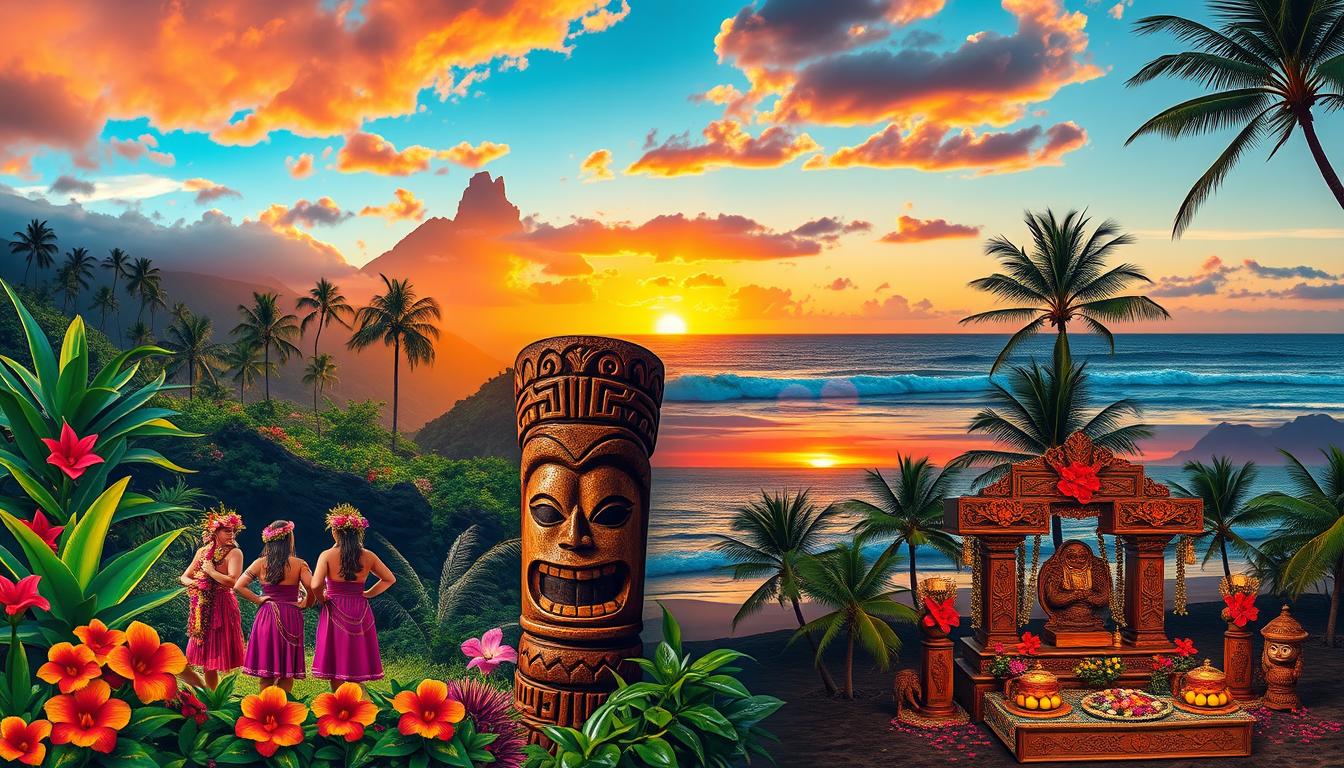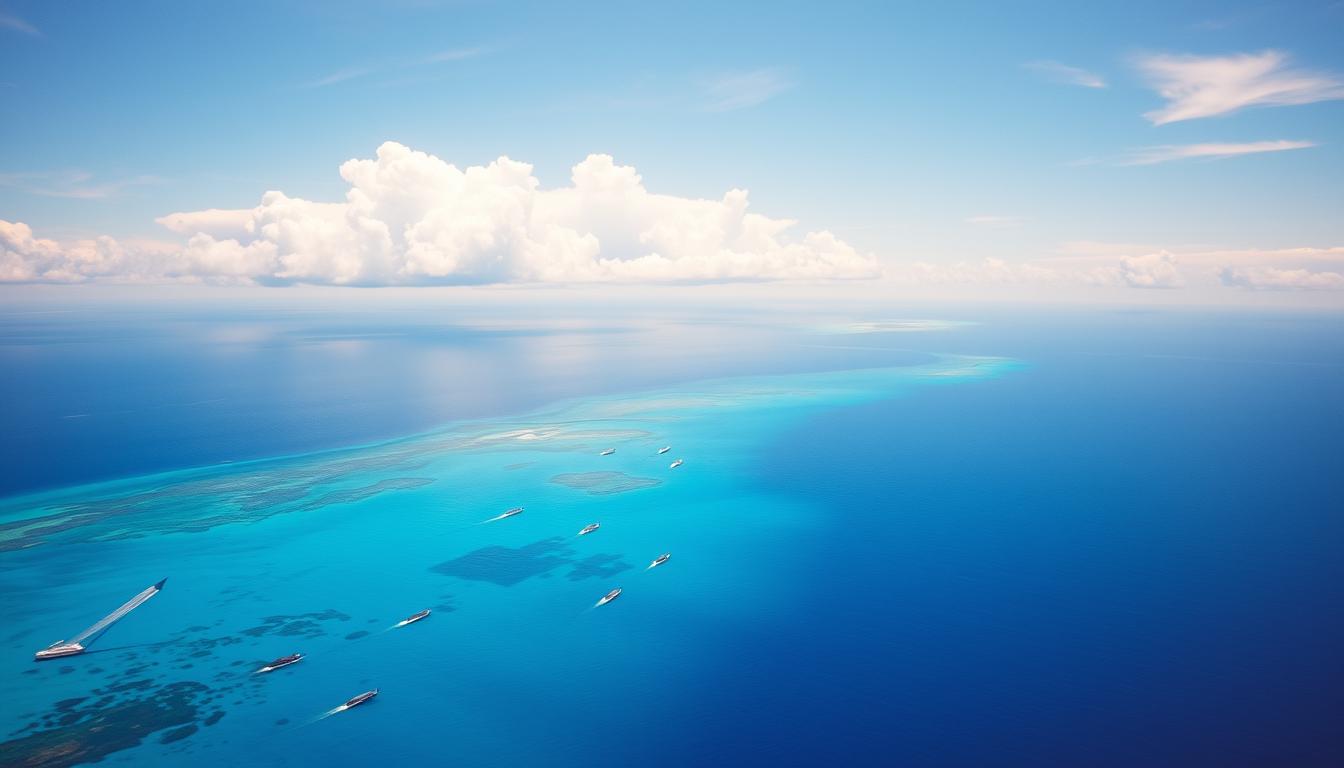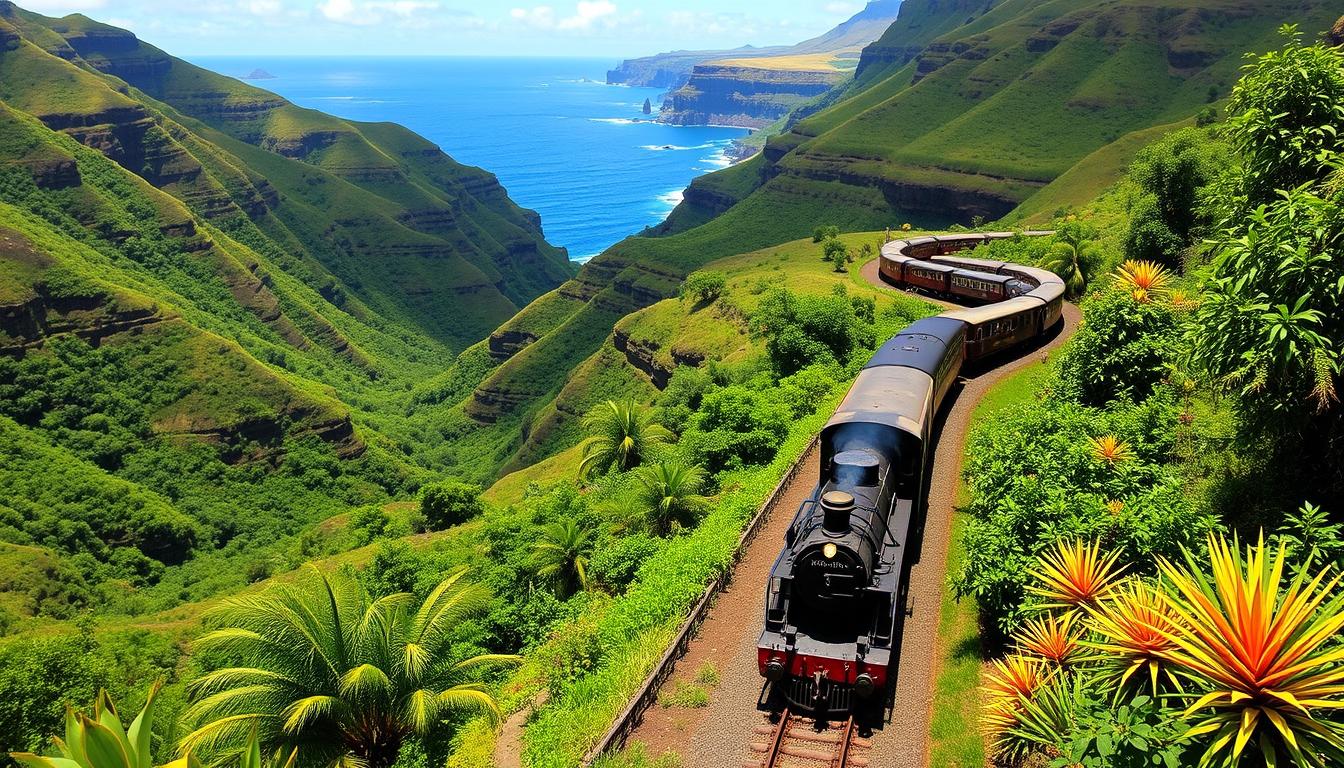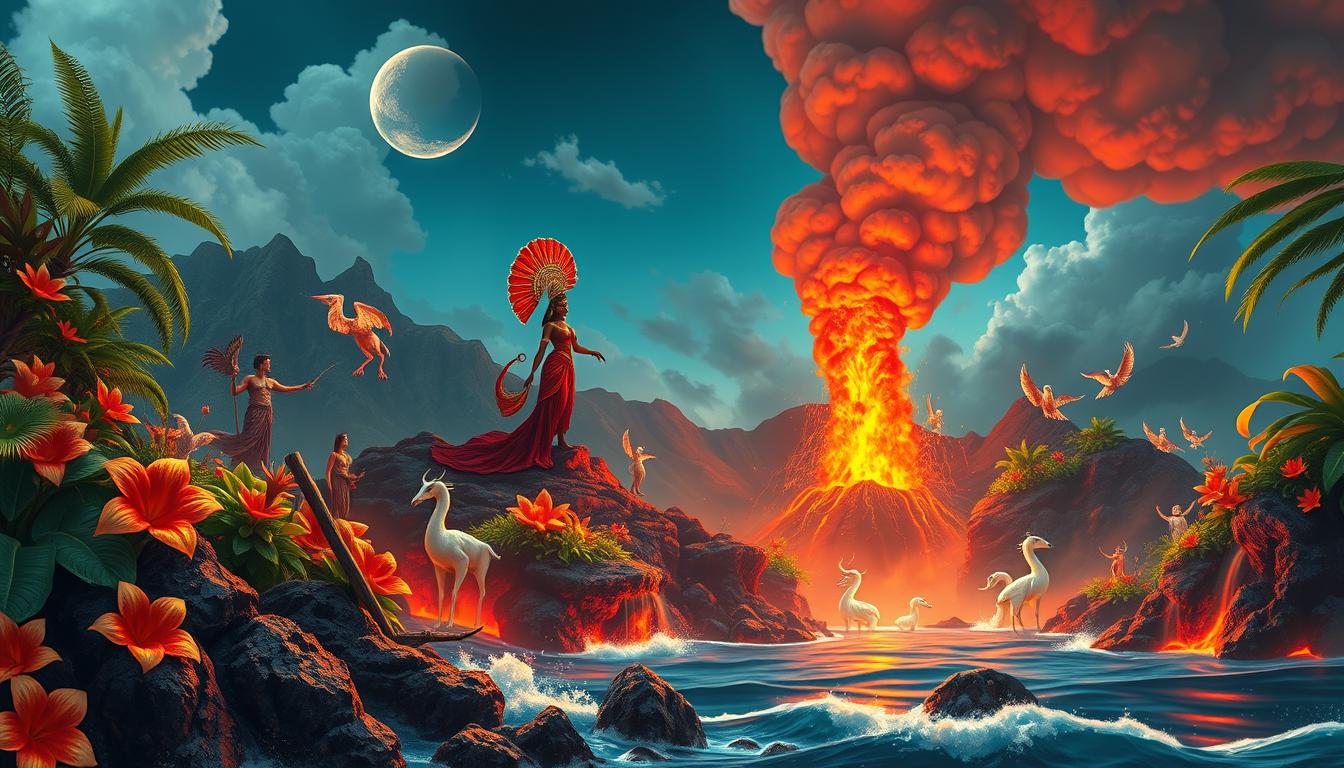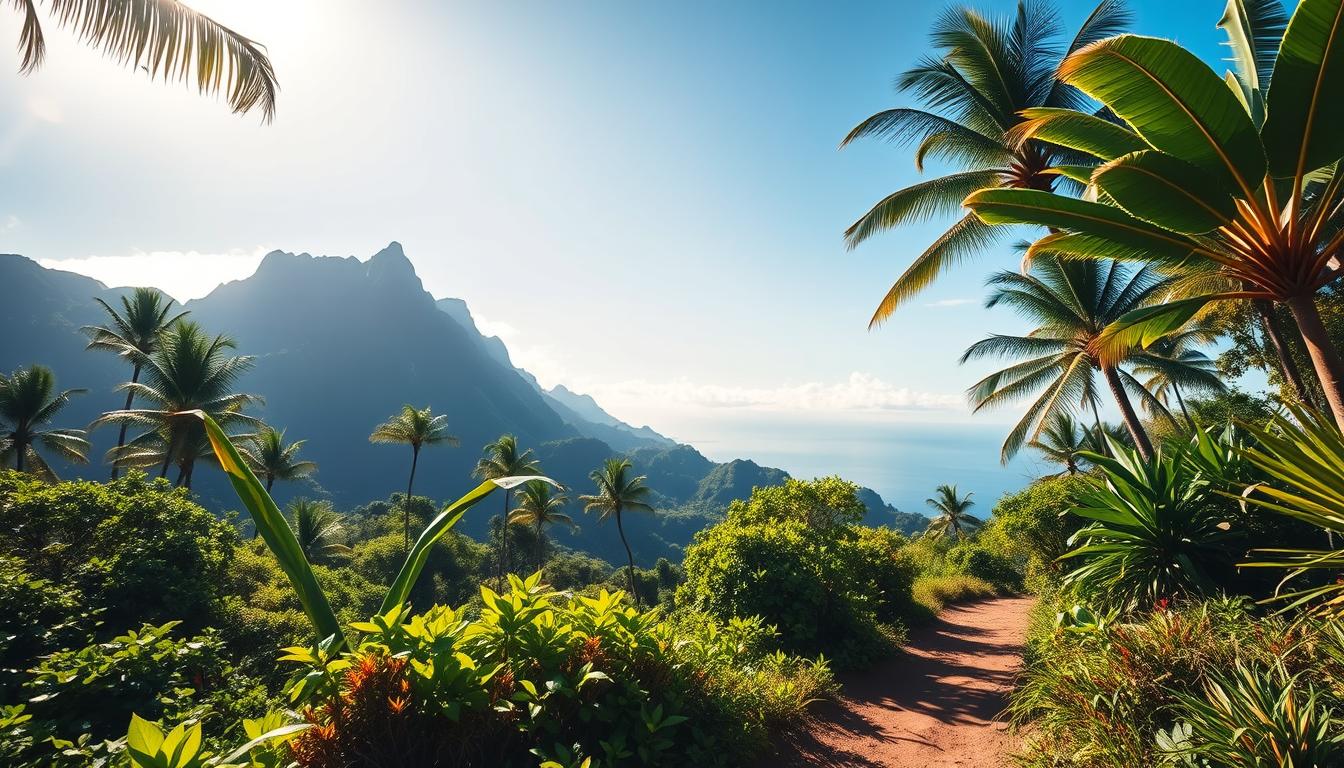Hawaii’s cultural landscape is a rich blend of influences. It includes the native Hawaiian people, Christian missionaries, and immigrant laborers from sugar cane plantations. This diverse mix has sparked a vibrant cultural renaissance, especially since the 1970s.
At the core of this revival is a focus on the Hawaiian language and key cultural elements. These include the voyaging canoe, tattooing, traditional music, kapa making, and the hula dance. Today, most Hawaiians know some Hawaiian words and participate in cultural practices like the lei exchange. The “Aloha Spirit,” though commercialized, still embodies the harmony among diverse groups on the islands.
Key Takeaways
- Hawaii’s culture is a diverse tapestry of influences, from native Hawaiians to Christian missionaries and immigrant laborers.
- A cultural renaissance since the 1970s has revived traditional Hawaiian practices, such as the Hawaiian language, voyaging canoes, and the hula dance.
- Most Hawaiians know some Hawaiian words and observe cultural traditions like the lei exchange.
- The “Aloha Spirit” reflects the coexistence of diverse groups on the islands.
- Hawaii’s unique local customs include discreet communication of relationship status and a prohibition on using car horns.
The Essence of Hawaiian Culture
Hawaii’s cultural landscape is a dynamic blend of diverse influences. These have shaped the islands’ identity. Colonialism once threatened the Native Hawaiian culture. Yet, a cultural renaissance in the 1970s revitalized the traditional heritage seen today.
Cultural Milieu: A Vibrant Renaissance
The heart of this renaissance was a focus on the Hawaiian language and cultural practices. The revival of the voyaging canoe, traditional tattooing, kapa creation, and hula performances were key. The “Aloha Spirit” symbolizes the harmony among diverse groups in Hawaii.
Honoring the Land and Ocean
Hawaiians’ bond with nature is central to their culture. Their practices, like sustainable farming and marine stewardship, reflect this. Environmental themes in their art and stories inspire visitors to the islands.
| Island | Cultural Attractions |
|---|---|
| Maui | 1 listing |
| O’ahu | 3 listings |
| Island of Hawai’i | 4 listings |
Native Hawaiian Cultural Heritage
Connection to the Northwestern Hawaiian Islands
The Native Hawaiians were the first to discover the Hawaiian Archipelago, inhabiting these islands for millennia before Western contact. They developed sophisticated resource management systems and specialized skills to thrive in these limited environments. Today, they maintain a deep connection to the land and sea, recognizing the intrinsic link between managing the islands and waters.
The Northwestern Hawaiian Islands (NWHI) hold a sacred place in Native Hawaiian culture. They are seen as a region of primordial darkness, where life springs and spirits return after death. Much of the knowledge about the NWHI has been passed down through oral and written histories, genealogies, songs, dance, and archaeological resources. Ethnological studies highlight the continuity of Native Hawaiian traditional practices and histories in this remote archipelago, though only a fraction of these have been formally recorded.
Historical expeditions to the NWHI were initiated by Hawaiian ali’i (royalty) from 1857 through 1894, underscoring the long-standing connection between Native Hawaiians and this region. The “Apology Bill” (U.S. Public Law 103-150), signed in 1993, recognized Native Hawaiians’ sovereignty, life, and responsibility for the Hawaiian Archipelago. A 2006 presidential proclamation further affirmed that activities supporting the perpetuation of traditional Native Hawaiian knowledge are allowed in the NWHI.
| Key Fact | Data |
|---|---|
| Native Hawaiians have inhabited the Hawaiian Archipelago | for thousands of years prior to Western contact |
| The ocean played a significant role in Native Hawaiian culture | as a resource for physical and spiritual sustenance |
| Definitions of Native Hawaiian practices and subsistence use | differ across various marine managed areas in Hawaii |
| Native Hawaiian practices within the Monument are defined | as cultural activities that perpetuate traditional knowledge and have demonstrable benefits to the Native Hawaiian community |
Historical Expeditions and Hawaiian Sovereignty
When Western Europeans first made contact with the Hawaiian Islands, most of the population was unaware of the Northwestern Hawaiian Islands. Few had ventured to these distant islands. Yet, over the next century, Hawaiian ali’i (royalty) led several expeditions to these islands. Their goal was to bring them under Hawaiian control and ownership.
The sovereignty, life (ea), and responsibility (kuleana) for the entire Hawaiian Archipelago remain deeply significant to many Native Hawaiians. This importance was formally acknowledged by the “Apology Bill” (U.S. Public Law 103-150). It was signed by the President in 1993.
The historical expeditions and ongoing recognition of Hawaiian sovereignty have been vital in preserving the cultural heritage and traditions of the Hawaiian Islands. These efforts have ensured that the rich cultural legacy of the Hawaiian ali’i and the people of the Hawaiian Archipelago are honored and protected for future generations.
As the world evolves, preserving and celebrating the unique cultural identity of the Hawaiian Islands is more crucial than ever. Through ongoing efforts to explore history and uphold sovereignty, we can ensure the vibrant traditions and customs of the Hawaiian people continue to thrive. They inspire people worldwide.
Cultural Access and Native Hawaiian Practices
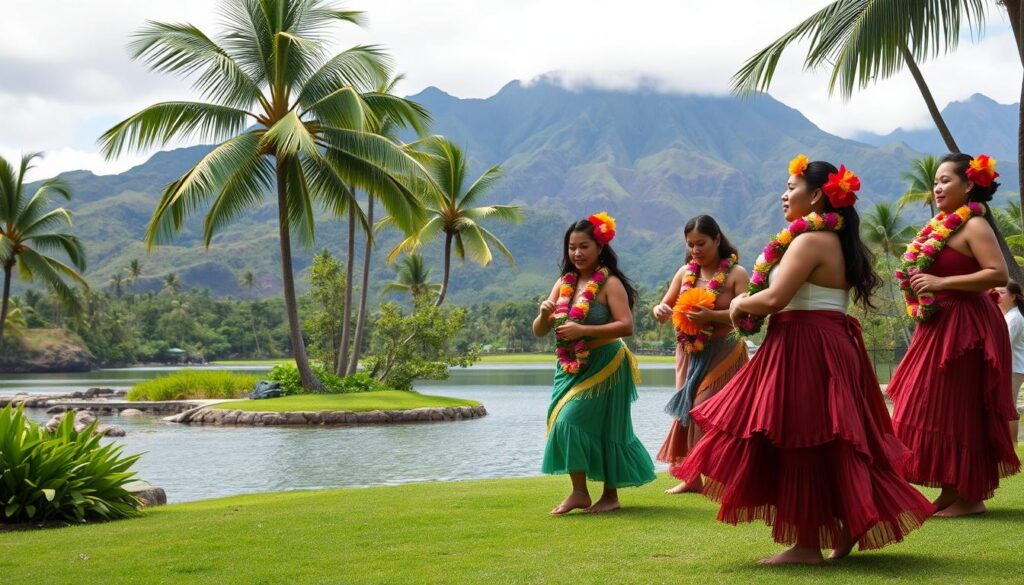
The Papahānaumokuākea Marine National Monument, established in 2006, recognizes the value of preserving Native Hawaiian cultural practices and traditional knowledge. The Proclamation allows certain activities if they “support or advance the perpetuation of traditional knowledge and ancestral connections of Native Hawaiians to the Northwestern Hawaiian Islands.”
Definition of Native Hawaiian Practices
The Monument defines “Native Hawaiian Practices” as cultural activities that benefit the Native Hawaiian community. These include practices that preserve traditional knowledge, care for the environment, and strengthen cultural and spiritual ties to the Northwestern Hawaiian Islands.
Native Hawaiians have been actively involved in cultural activities within the Monument. In 1997, Hui Mālama i Nā Kūpuna o Hawai’i Nei repatriated human remains to Nihoa and Mokumanana, which were collected by archaeologists in the 1920s. In 2003 and 2005, cultural protocol groups conducted traditional ceremonies on Nihoa and Mokumanamana.
The Monument’s definition of Native Hawaiian practices aligns with the goals and objectives of the Papahānaumokuākea Marine National Monument. It also reflects the recommendations of the Reserve Advisory Council from 2004. This recognition and protection of Native Hawaiian cultural access and practices is further enshrined in the Hawai’i State Constitution.
Despite these efforts, challenges persist in fully upholding traditional and customary practice rights. The Native Hawaiian Legal Corporation (NHLC) has fought legal battles to secure these rights. For example, they have worked to ensure the right to practice indigenous religion while incarcerated on the mainland. Ongoing efforts aim to provide access to Hawaiian language immersion schools for Native Hawaiian students in the public school system.
Preserving Native Hawaiian practices, such as the restoration of loko iʻa (fishponds) for watershed management and food sovereignty, remains a crucial priority in the region.
Hawaiian culture and traditions
The Native Hawaiians have a rich cultural heritage spanning centuries. They migrated to the Hawaiian Islands and thrived, developing a unique way of life. They preserved many customs and traditions, including the iconic honi ihu (touching of noses) and the vibrant lei (garland or wreath). Hawaiian culture is a tapestry of deeply meaningful practices.
The hula, a complex art form, holds a special place in Hawaiian society. It is performed for religious purposes, entertainment, and to preserve historical events, genealogy, and mythology. The hula is a captivating and revered expression of the Hawaiian spirit. Additionally, the concept of malama aina, or caring for the land, is a fundamental tenet of the Hawaiian way of life.
Hawaiians have long celebrated their customs through various festivities, including the paina (dinner party) and the ahaaina (feast). These gatherings, often misinterpreted by 19th-century newspaper reporters, became known as luau. The term originally referred to the taro tops, a common ingredient in Hawaiian cuisine.
| Hawaiian Cultural Traditions | Description |
|---|---|
| Honi ihu | The touching of noses, a traditional form of greeting and showing affection. |
| Lei | A garland or wreath made of flowers, leaves, shells, or other natural materials, used for various occasions and to express affection. |
| Hula | A complex, traditional dance form that serves religious, entertainment, and historical purposes. |
| Malama aina | The concept of caring for and respecting the land, a fundamental aspect of Hawaiian culture. |
| Paina and ahaaina | Hawaiian terms for dinner parties and feasts, often mistakenly referred to as “luau”. |
The Native Hawaiian culture represents a rich tapestry of traditions, deeply rooted in their connection to the land, ocean, and the divine. These customs continue to be celebrated and passed down, preserving the essence of the Hawaiian way of life.
Contemporary Links to Hawaiian Islands
Native Hawaiians maintain a profound connection to the Northwestern Hawaiian Islands. This bond is rooted in genealogy, culture, and spirituality. Recently, Native Hawaiian cultural practitioners have embarked on voyages to the Northwestern Hawaiian Islands. Their goal is to honor their ancestors and continue traditional practices.
Voyaging and Honoring Ancestors
In 1997, Hui Mālama i Nā Kūpuna o Hawai’i Nei returned human remains to Nihoa and Mokumanana. These remains were collected by archaeologists in the 1924-25 Bishop Museum Tanager Expeditions. This repatriation was a crucial step in acknowledging Native Hawaiians’ ancestral ties to the Northwestern Hawaiian Islands.
In 2003, a cultural protocol group named Nā Kup’eu Paemoku visited Nihoa aboard the Hōkūle’a canoe. They conducted traditional ceremonies during their voyage. This event was pivotal, allowing Native Hawaiians to reconnect with their ancestral homeland. It also helped preserve their cultural traditions.
| Year | Event | Significance |
|---|---|---|
| 1997 | Repatriation of human remains to Nihoa and Mokumanana | Honoring ancestral connections of Native Hawaiians to the Northwestern Hawaiian Islands |
| 2003 | Voyage of Nā Kup’eu Paemoku to Nihoa on the Hōkūle’a canoe | Reconnecting with ancestral homeland and upholding cultural traditions |
These voyages and repatriation efforts highlight the Native Hawaiian contemporary connections to the Northwestern Hawaiian Islands. They underscore the significance of voyaging and ancestral connections in safeguarding their cultural heritage.
The Arts and Cultural Institutions
Hawaii’s cultural scene is alive and well, with many people attending various artistic venues. From art galleries and film festivals to concert halls and theaters, there’s something for everyone. The Bernice P. Bishop Museum, established in 1889 in Honolulu, is a key research center and museum. It focuses on preserving and showcasing the Pacific region’s history, sciences, and cultures.
The Honolulu Academy of Arts is another gem, boasting a vast collection of Western art and one of the finest Asian art collections globally. This institution enriches the cultural landscape of Hawaii.
The Honolulu Symphony Orchestra and the Hawaii Opera Theatre are pillars of performing arts in Honolulu and the major islands. They have been instrumental in fostering a love for classical, modern, and experimental art. Both institutions have a significant impact on the local community and visitors.
| Cultural Institution | Highlights |
|---|---|
| Bernice P. Bishop Museum | A research center and museum dedicated to the study, preservation, and display of the history, sciences, and cultures of the Pacific and its peoples. |
| Honolulu Academy of Arts | Houses a splendid collection of Western art and one of the finest collections of Asian art in the Western world. |
| Honolulu Symphony Orchestra | A renowned performing arts institution that showcases classical, modern, and experimental art forms. |
| Hawaii Opera Theatre | A leading opera company that performs in Honolulu and other major islands, contributing to the cultural enrichment of the community. |
These cultural institutions in Hawaii are crucial for preserving and promoting the islands’ diverse artistic expressions. They serve as vital hubs for community engagement, education, and celebrating Hawaiian cultural heritage.
Sports, Recreation, and National Parks
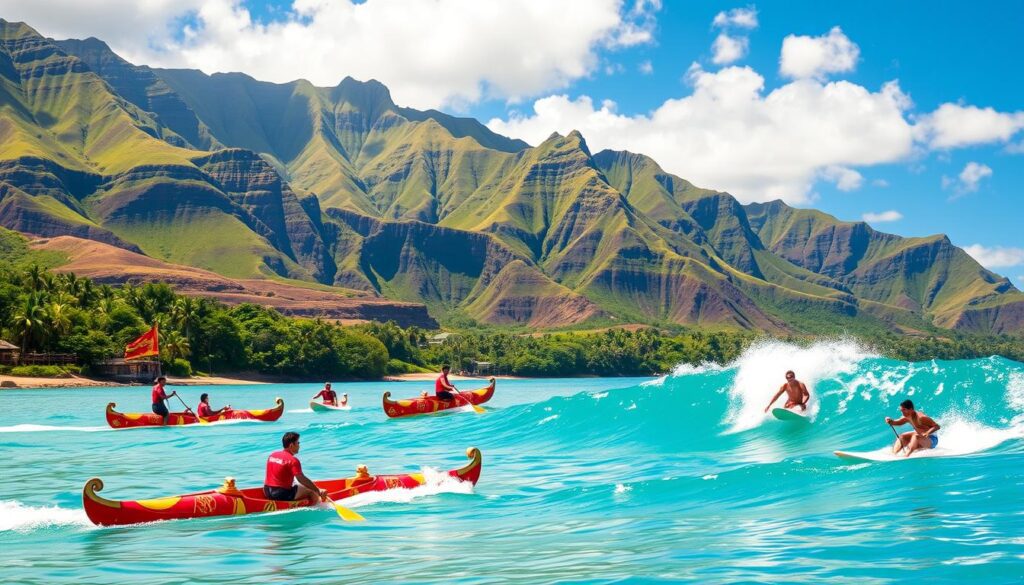
Hawaii is a paradise for sports lovers and outdoor enthusiasts. Surfing, deeply rooted in ancient Polynesian culture, became a modern sport in Hawaii in the early 20th century. The Banzai Pipeline, Waimea Bay, and Sunset Beach on Oahu’s North Shore are legendary among surfers worldwide.
Baseball’s history in Hawaii dates back to the 1850s. The Hawaiian Baseball League has been a launching pad for many professional careers. Football, especially the University of Hawaii’s team, holds a special place in the hearts of locals.
The Honolulu Marathon, one of the world’s largest, has been held since 1973. It draws runners globally, offering a chance to see Hawaii’s beauty while pushing physical limits.
Hawaii boasts two breathtaking national parks. Hawaii Volcanoes National Park, a UNESCO World Heritage site since 1987, showcases landscapes shaped by volcanoes. Haleakala National Park, on Maui, is famous for its volcanic crater and diverse ecosystems.
Hawaii offers a wide range of activities, from surfing the North Shore to hiking in national parks. It’s a place where visitors and locals can dive into the islands’ natural beauty and rich culture.
| Sport/Activity | Participation Rates |
|---|---|
| Recreational Fishing | $4.5 billion industry, 55 million participants |
| Swimming | 50 million Americans, 3,100 professional clubs |
| Canoeing/Kayaking | 9.6 million canoers, 13 million kayakers |
| Surfing | 3.8 million surfers, $50 billion global economic impact |
Hawaiian Media and Publishing
Hawaii’s media scene is rich and varied, featuring newspapers, radio, and TV stations that showcase the state’s cultural diversity. The Honolulu Star-Advertiser, Hawaii Tribune-Herald (Hilo), and Maui News are key players, each focusing on their respective local communities. These publications are essential for keeping residents informed and connected.
The media landscape also caters to Hawaii’s diverse ethnic groups. For example, the Hawaii Herald targets the Japanese American community, offering content in both English and Japanese. Moreover, radio and TV stations broadcast in multiple languages, including Japanese and Korean, to meet the needs of Hawaii’s multilingual residents.
The history of Hawaiian media is as fascinating as it is long. The first newspaper, Ka Lama Hawaii (The Hawaiian Luminary), was printed in 1834 on Maui. The following year, Ke Kumu Hawaii, the first regular Hawaiian-language newspaper, was launched.
Over the years, the media landscape evolved significantly. The Sandwich Island Gazette and Journal of Commerce, the first English paper, debuted in 1836. The Pacific Commercial Advertiser, the first regular English paper, followed in 1856. The Hawaiian Kingdom also had its own English/Hawaiian newspaper, the Polynesian, starting in 1841.
In the 20th century, media began to serve Hawaii’s diverse ethnic communities more directly. The Hawaii Hochi (Hawaii News), the first daily Japanese language newspaper, was launched in 1912. The Kona Hankyo (Echo), a Japanese newspaper in Kona, operated from 1893 to 1941.
Today, Hawaiian media remains crucial for preserving and celebrating the state’s cultural heritage. It acts as a bridge for exchanging ideas, news, and perspectives that highlight the vibrant essence of the Hawaiian islands.
The significance of Hawaiian media cannot be overstated. It is a vital platform for information sharing, cultural preservation, and civic engagement. From the early days of Hawaiian language newspapers to the modern media scene, the story of Hawaiian media showcases the resilience and adaptability of Hawaii’s diverse communities.
Preserving Native Hawaiian Customs
Despite the influence of diverse cultures and colonialism, many Native Hawaiian customs endure. The focus on the Hawaiian language and cultural practices like voyaging canoes and traditional music remains strong. The hula, in particular, has seen a resurgence, showcasing the resilience of Native Hawaiian traditions.
The “Aloha Spirit” symbolizes the coexistence of various cultures on Hawaii’s islands. Efforts by organizations like the Edith Kanaka’ole Foundation and the Office of Hawaiian Affairs are crucial. They offer cultural education and preservation programs. Schools such as Kamehameha Schools also integrate native culture and language into their curriculum.
However, the blending of mainland U.S. and Hawaiian cultures has diluted some native practices. The lack of recognition for the Hawaiian language and the misuse of sacred lands hinder cultural preservation. Challenges like representation, commercialization, and authenticity threaten the integrity of Native Hawaiian culture in a globalized world.

Scott Sweeney is the creator of Virtual Hawaii 360. Scott is a professional marketer and a lifelong Hawaii enthusiast. Scott splits time between Oahu and Dayton, Ohio. In addition to his marketing endevours, he is also a published Ukulele musician.

